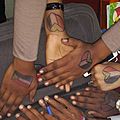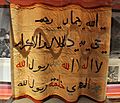Flag of Sudan facts for kids
The flag of Sudan was chosen on 20 May 1970. It has three horizontal stripes: red, white, and black. On the left side, closest to the flagpole (this part is called the "hoist"), there is a green triangle.
This flag design is inspired by the Arab Liberation Flag. Many other Arab countries, like Egypt, Iraq, Syria, and Yemen, also use similar designs. These flags often feature what are known as the Pan-Arab colours. These colors – red, white, black, and green – are important symbols for Arab nations. They often represent things like independence, unity, and the history of the Arab people.
Colors and Their Meanings
The colors on Sudan's flag each have a special meaning:
- Red stands for the struggle and sacrifices made for Sudan's independence. It also represents the blood of the martyrs.
- White symbolizes peace, light, and optimism. It also represents the purity of the Sudanese people.
- Black represents Sudan itself, as "Sudan" means "land of the blacks." It also reminds us of the Mahdist Revolution of the 19th century.
- Green stands for prosperity, agriculture, and Islam, which is an important religion in Sudan.
History of the Flag
Before 1970, Sudan used different flags. For example, during the time when Sudan was ruled by both Britain and Egypt (called Anglo-Egyptian Sudan), a different flag was used. The current flag was adopted after Sudan gained full independence and wanted a design that truly represented its own identity and its connection to other Arab nations.
Images for kids
-
People holding flags during the Sudanese Revolution (2018–19).
-
A flag used in Anglo-Egyptian Sudan between 1914 and 1922.
See also
 In Spanish: Bandera del Sudán para niños
In Spanish: Bandera del Sudán para niños





